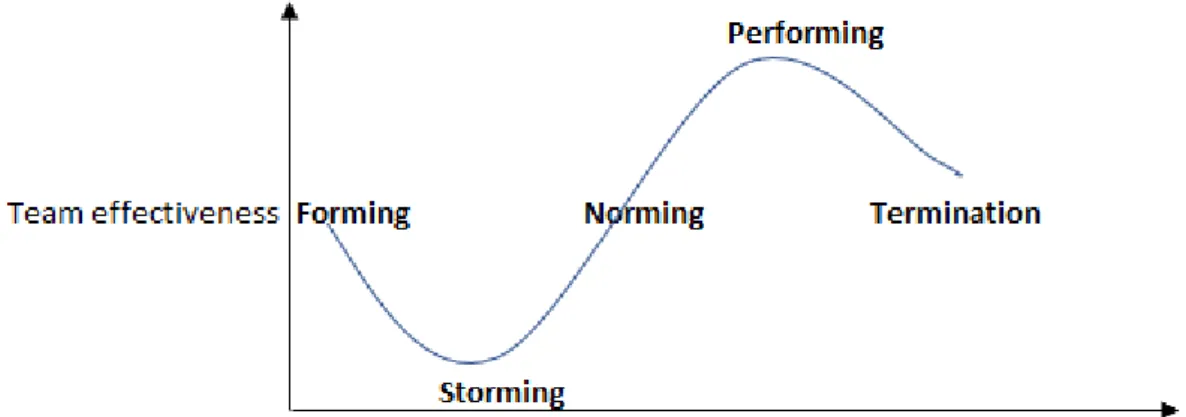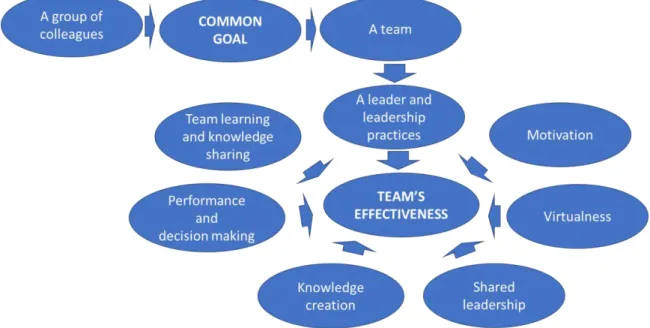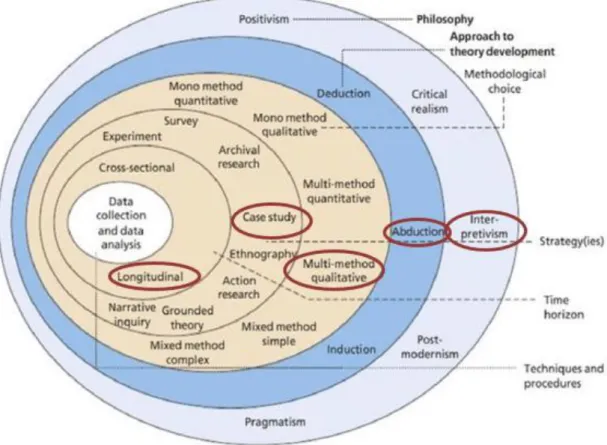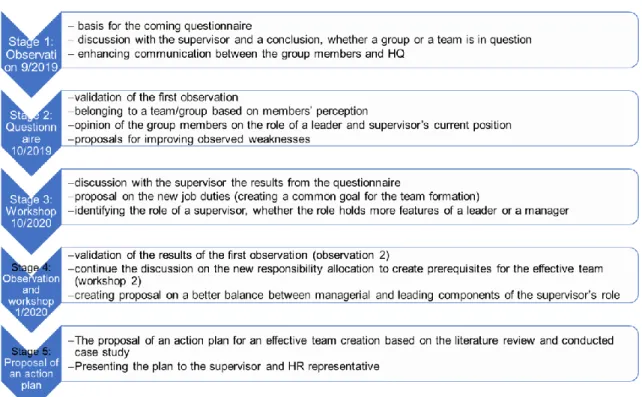That part of the team has been together for a long time and has a fairly close cooperation, and the other part are "newcomers" who have to prove themselves. One part of the group/team has been together for a long time (over 10 years) and has a fairly close cooperation, and the other part are "newcomers".
Team characteristics
- What is the difference between a group and a team?
- Team development
- Team learning
- Attributes of an effective team
It is important for the manager to be aware of the existence of knowledge and the transfer of knowledge in the team. The leader must ensure that the knowledge that existed or gained is transferred to the rest of the team.
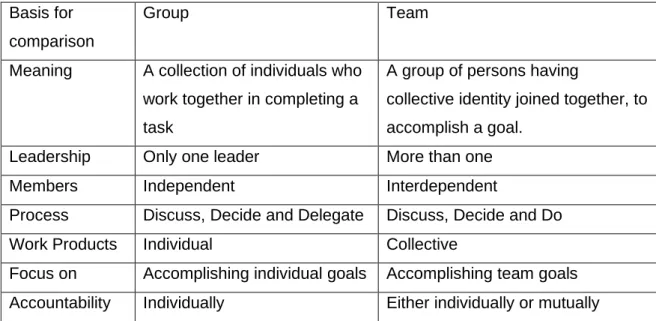
Role of a manager/leader in building and managing the team
Motivation
The list goes on, but the leader needs to know the team members to offer the right motivation. One of the methods suggested by Peterson (2007) for a leader is to be open about issues and try to correct discrepancies by providing details about the matter, this point is also mentioned by Bryant (2017) that open conversations are vital for team progress.
Knowing and doing
The team can only succeed if the values and objectives are consistent with those produced by the organization. The dimensions involved in team dynamics and effectiveness are not simple, and team analysis would require a good understanding of the team's motivations for actions, the position of the leader. Pfeffer & Sutton (2000) mention the harm of internal competition, which seems to be particularly dangerous for the team as a whole, which is committed to the common goal.
Cessan (2020) proposes an interesting technique to set the individual goals with the team, the team participates in setting goals of an individual. The concept includes the idea that goals set by the team are valuable to the team's progress and more relevant to the team's goal. Again, the author mentions that the leader needs to understand team dynamics to assess whether he is ready for a different perspective on goal setting, for example, on the norming and storming stages. Such an approach may not be successful (Cessan 2020).
Team performance and decision making
Team effectiveness is also influenced by the level of agreeableness of team members through communication and cohesion (Bradley, Baur, Banford & Postlethwaite 2013). Furthermore, it is a great challenge and even a danger when the team cannot decide collectively and turn to the leader to decide, as the decision will satisfy only a small part of the team (Frisch 2008). Larson (2017) states that decision-making teams triple the number of options provided for decision-making.
Frisch (2008) also mentions that the safe atmosphere should be created so that the team members should not be afraid to produce the possibilities for the problem solving, as well as that the appropriate amount of time should be allocated to the process. As mentioned before, the number of options for the decision increases in the team's decision-making process, which creates the risk of having too many and not being able to handle all the proposals. As a final step, mentioned by Larson (2017), the appropriate communication of the decision is when the rationale and details of the decision are opened to the team members.
Virtual teams
Malhotra, Rosen & Majchrzak (2007) present six leadership practices that help maintain the team effectively in the virtual environment. It is more difficult for the leader to monitor the progress of the team in virtual mode because there are no opportunities for physical observations. Meeting or missing the deadline is also a good gauge for the leader to track the team's progress.
The fifth exercise for the leader is to make the virtual team visible (Malhotra et al. 2007). The last one of the practices is for the leader to ensure that the team members benefit from participating in the virtual team (Malhotra et al. 2007). The members must be able to grow, learn and develop, so the motivation is up, and employees are committed to the team's goal and improve the performance.
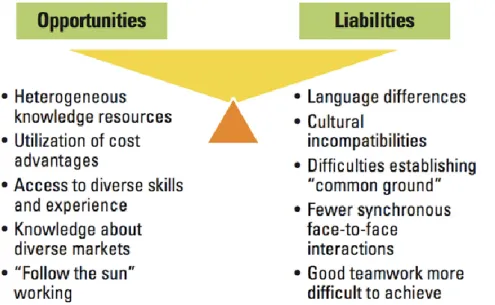
Conceptual framework
Among the most important factors for team effectiveness is knowledge creation and then knowledge sharing (Ihrig & MacMillan 2015; Pfeffer & Sutton 2000). Motivation of a team as well as each member of a team can be triggered by different factors, some people are motivated by being part of an effective team, some by doing a complex task, the role of a manager is to know the factors that inspire team members and to be able to keep motivation at the right level so that members can commit to the team's goals (Burke & Barron 2014; Schmid & Adams 2008). The leader is responsible for monitoring the team dynamics and forming the deep team understanding in order to execute corrective actions and return the team to the high performance level (Peterson 2007; Chartrand 2017).
The leader should be able to make the work results of a virtual team visible and valued in the rest of the organization, but there is also a pressure to keep track of team's achievements (Malhotra et al. 2007). In the content of virtual teams, the concept of shared leadership is raised as an answer to the less control and monitor of the leader, in such a case the team can create the self-leadership qualities (Liao 2017). The conceptual framework is a summarized literature review, which showed a major role of a leader in making the team effective and performing.
Research methodology and research strategy
This chapter describes the research methodology and methods used to design the research as well as explains the data collection methods. The research philosophy of the study is interpretivism, which aims to analyze complex world, in this case business/management. The research approach is abduction (Saunders et al. 2012, p147), which gives the indisputable advantage: it allows the researcher to follow some theoretical leads, discover some insights during the research and go back to the theory , when necessary.
The research strategy for the study is a case study, which is focused on single-case in-depth analyzes in the real world (Saunders et al. 2012, p.179). The author used few methods to examine the data, making it a qualitative research multi-method (Saunders et al. 2012, p.165). For the case study to be effective, it is important to bind it, the formulation of the research questions and the planning of the research (participants, location) will help to achieve this goal (Harrison et al. 2017).
Data collection
The author of the thesis will try to interpret the team's social actions and analyze the reasons behind them. The questionnaire was anonymous (on paper) and required an answer from each member of the group. One of the benefits of the workshop is that this method allows for collaboration between the participants (Ørngreen & Levinsen 2017), yielding enriched data.
Also on the agenda were the analyzes of the group members from the point of view of mutual cooperation and the determination of the strengths and expertise of each member. This gave certain advantages, the main one being easier access to information, on the other hand, the researcher could take certain information for granted, be less critical, which increased the importance of objectivity in research. The author took confidentiality very seriously, as well as the human aspect, since the research was conducted with people.
Validity and reliability of the research
Overview of the case study stages
In the previous chapter, the methodological approach to the research was described, and this chapter covers the implementation of the case study and the results. Action plan proposal for effective team building based on literature review and conducted case study.
Stage 1: Observation
The employees' traits were noted based on the set goals for the observations. The general conclusion was the lack of interest in common affairs, the main focus was on the own geographical area of responsibility. The supervisor has the opportunity to get an overview of the past week and inform about the situation at the headquarters.
Based on the feedback and conclusions from the first observation, there was a discussion with the supervisor about whether these employees form a group or a team. Based on the main differences between a team and a group, the analysis shows that the subdivision is a group rather than a team (Table 3, Surbhi 2015). Based on the goals set by the supervisor, that team was more preferable and he wanted to build a team as the goal is common to the division and should be addressed accordingly.
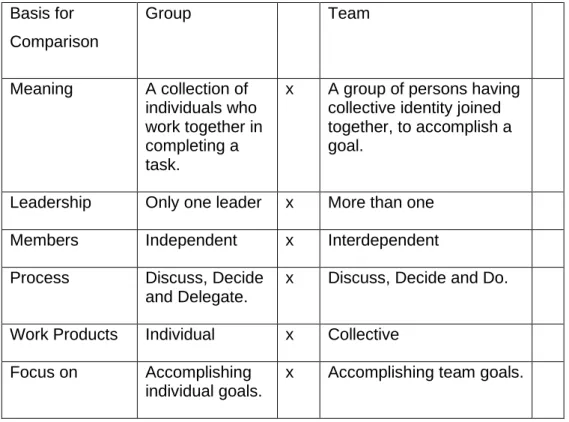
Stage 2: Questionnaire
One explanation could be that almost all respondents said they would like more connection with the leader, more communication, more team building, support and mindfulness.
Stage 3: Workshop
Stage 4: Second observation and second workshop
Stage 5: Proposal of an action plan
This chapter summarizes the research carried out, whether it answered the research questions posed, opens up the value of the case study for the client's company, suggests possible future research areas and reflects on the learning process of the author of the thesis.
Objectives and research questions
During the research carried out, including the literature review, it came to light the undeniable role of a leader in making the team function in an effective and efficient manner. There is no one rule or clear method how to create an effective team, nevertheless the leadership practices used by the leader shape the team. The leader must be aware of the team's dynamics, what state the team is in, the goal is to keep the team at the performance stage, when the team is at its most effective.
When the team slips the stages of development, corrective measures should be taken by the manager, the most important thing is open communication. The virtuality aspect was also highlighted, as the team in question is located in the various remote locations, and during the thesis writing, the corona pandemic shifted even more focus to virtual team management. Although the group serves certain purposes and can be effective in carrying out group tasks for which each member is responsible and accountable for his own task, it was clearly stated that in this study the team was more suitable.
Value of the study for the organisation
Recommendations for further research
Reflection on own learning
Project Management Leadership: Building Creative Teams, Edition 2. Set individual goals with the entire team. https://www.viktorcessan.com/one-way-to-fix-talent-management-that-gets-in-the-way-of-effective-team-work/. 4 tips to help. Inspire the entire team with conscious leadership. https://www.publicfinance.co.uk/feature/2018/06/inspire-whole-team-mindful-leadership. How to turn a group of strangers into a team. https://www.youtube.com/watch?v=3boKz0Exros.
How to lead in the age of new remote teams. https://enterprisersproject.com/article/2020/3/how-lead-newly-remote-teams. Maintaining high performance in your teams. https://generalleadership.com/?s=Sustaining+High+Performance+In+Your+Teams.
Field notes from the observations (confidential)
Questionnaire (confidential)
Questionnaire answers in a consolidated form (confidential)
